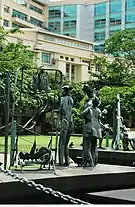Quezon Boulevard
Quezon Boulevard is a short stretch of highway in Manila, Philippines running north–south through the district of Quiapo. It is a six- to ten-lane 1.1-kilometer-long (0.68 mi) divided boulevard designated as a component of National Route 170 (N170) of the Philippine highway network and Radial Road 8 (R-8) of Manila's arterial road network which links the center of Manila to North Luzon Expressway in Quezon City in the north. The boulevard is the main access to the popular Quiapo Church and is one of the main thoroughfares of the University Belt area.
.svg.png.webp) R-8 | |
|---|---|
.jpg.webp) Quezon Boulevard north of Recto Avenue | |
| Namesake | Manuel L. Quezon |
| Maintained by | Department of Public Works and Highways - North Manila Engineering District Office[1] |
| Length | 1.1 km (0.7 mi) |
| Component highways | From Lerma to Quezon Bridge: |
| Location | Manila |
| North end | |
| Major junctions | |
| South end | Carlos Palanca Sr. Street in Quiapo, Manila |
History
Quezon Boulevard was developed as part of a national road plan to connect the government center of Manila in Rizal Park to the proposed new capital on the Diliman estate. It was built in 1939 over the old Calle Regidor, which was widened by demolishing all the buildings and houses on its east side and eventually combined with the old Calle Martin Ocampo.[2] It was also in 1939 when the old Puente Colgante, which connected the boulevard south over the Pasig River to Padre Burgos Avenue in Ermita, was replaced by the modern steel arch bridge, Quezon Bridge.
During Spanish colonial times, Calle Regidor was called Calle Santa Rosa, and Calle Martin Ocampo was Calle Concepcion. They were renamed in the early 1900s after La Solidaridad writer Antonio Maria Regidor and El Renacimiento and La Vanguardia editor Martin Ocampo, respectively. The new boulevard that replaced them was named after Commonwealth President Manuel Luis Quezon.
Route description
.jpg.webp)
.jpg.webp)
Quezon Boulevard begins at the foot of Quezon Bridge by the riverside Quinta Market on Carlos Palanca Sr. Street (formerly Calle Echague) as a continuation of Padre Burgos Avenue from Ermita and Intramuros. It intersects with Arlegui Street, which leads to San Miguel district and the Malacañang Palace complex, and Hidalgo Street (former Calle San Sebastian) which leads to San Sebastian Church, before arriving at Plaza Miranda and Quiapo Church, site of the annual Feast of the Black Nazarene. The boulevard then runs into a junction with Gonzalo Puyat Street (former Calle Raon) which leads west to Santa Cruz Church in Santa Cruz, and heads for Sampaloc district at the intersection with Recto Avenue. It ends at the junction with Lerma Street where it continues as Alfonso Mendoza Street (former Calle Andalucía), which heads north to the San Lazaro Tourism and Business Park.
Intersections
The entire route is located in Manila. Rizal Park is designated as kilometer zero.
| km[3] | mi | Destinations | Notes | ||
|---|---|---|---|---|---|
| Northern terminus. Continues north as Alfonso Mendoza Street. | |||||
| Diamond interchange; no left turn towards Recto Avenue | |||||
| 3 | 1.9 | Buenviaje Street | Northbound access only via service road to Recto Avenue | ||
| Soler Extension | Northbound access only | ||||
| Porvenir Street | Southbound access only | ||||
| Esperanza Street | Southbound access only | ||||
| De la Fe Street | Southbound access only | ||||
| Gonzalo Puyat Street | No access from opposite directions; one-way southbound entrance | ||||
| Paterno Street | Southbound access only | ||||
| Escaldo Street | Northbound access only | ||||
| Hidalgo Street | No access from opposite directions; Plaza Miranda on the west | ||||
| North end of Quezon Bridge (Route number changes from N170 to unnumbered)[3] | |||||
| Arlegui Street | Northbound access only | ||||
| Norzagaray Street | Northbound exit only | ||||
| Globo de Oro Street | One-way entrance | ||||
| Carlos Palanca Sr. Street | Southern terminus | ||||
1.000 mi = 1.609 km; 1.000 km = 0.621 mi
| |||||
Landmarks

- Bilibid Viejo (Manila City Jail)
- Far Eastern University
- Isetann Cinerama Recto
- Mercury Drug
- Plaza Miranda
- Quiapo Church
- Quinta Market
- Raon Electronics Center
See also
References
- "North Manila". Department of Public Works and Highways. Retrieved August 2, 2020.
- "Manila Extramuros" (PDF). Philippine Institute for Development Studies. Retrieved 11 July 2015.
- "Road and Bridge Inventory". Department of Public Works and Highways. Retrieved July 30, 2020.
